Hydrological Implications of Supplemental Irrigation in Cocoa Production Using SWAT Model: Insights from the Upper Offin Sub-Basin, Ghana
Abstract
1. Introduction
2. Study Area
2.1. Physical Setting and Climate
2.2. Land Use and Agriculture
2.3. Hydrogeology
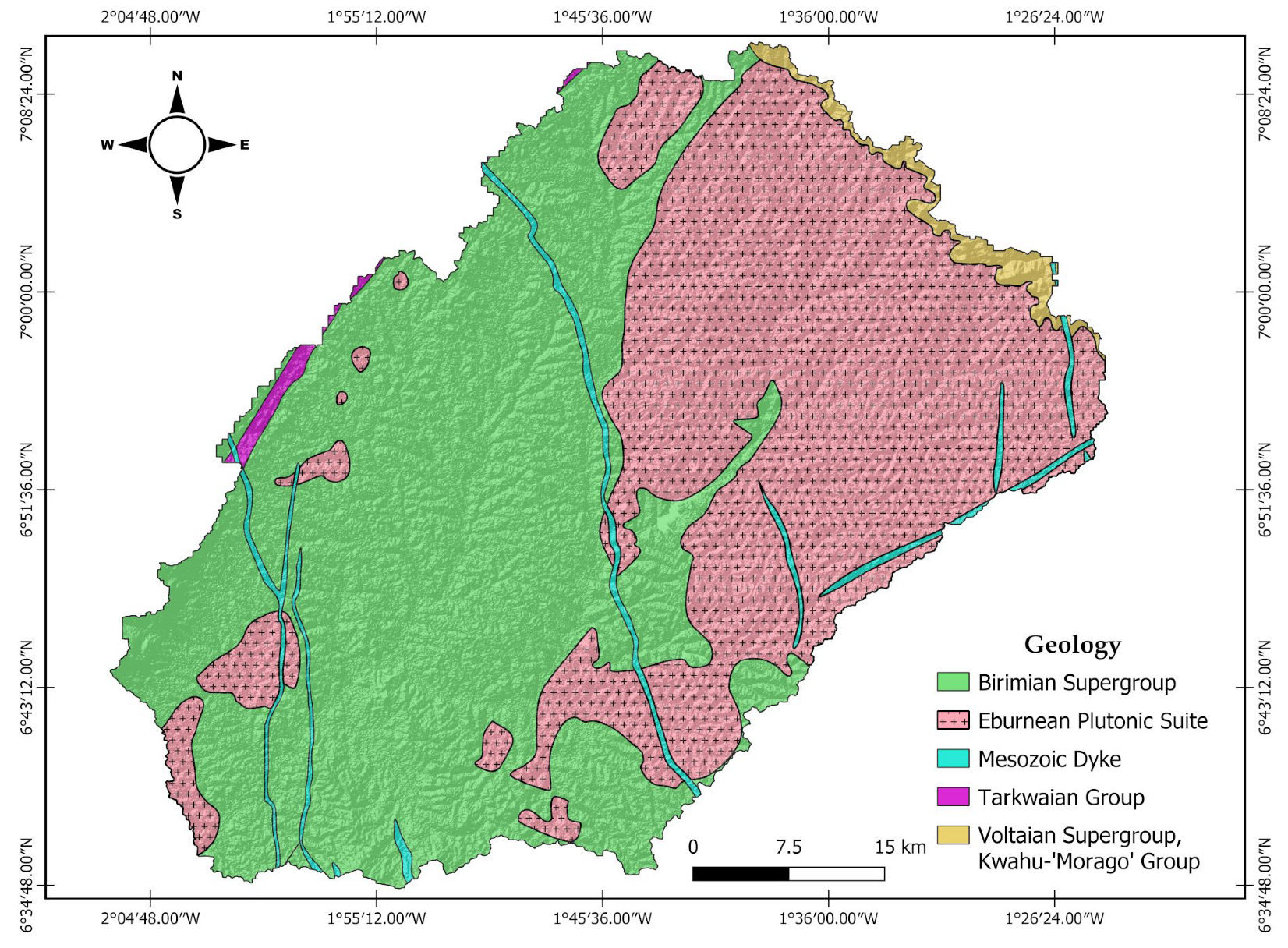
3. Materials and Methods
3.1. Framework of the Study
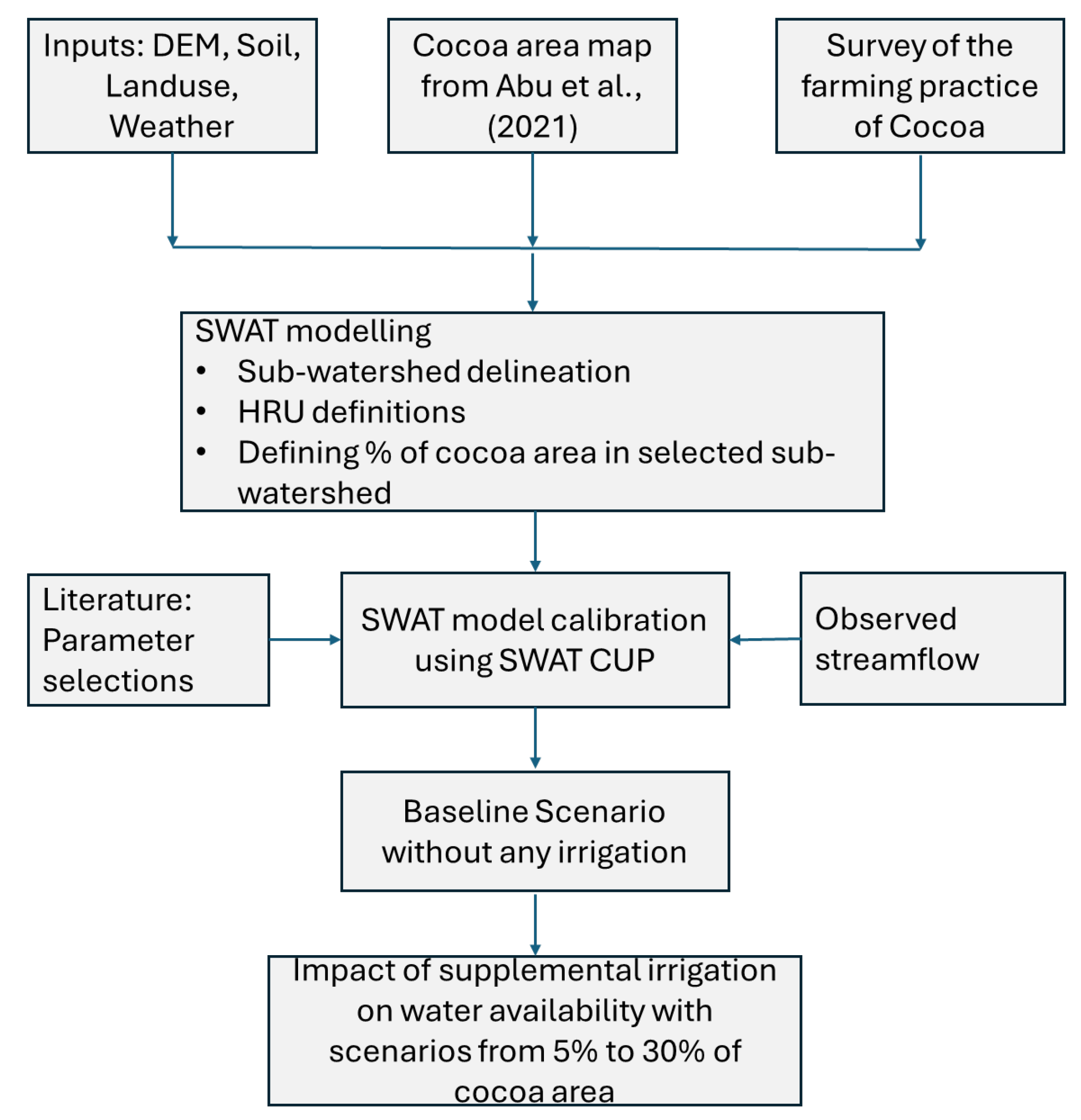
3.2. SWAT Model Description
3.3. SWAT Model Setup
3.4. Model Data Inputs
3.5. Model Sensitivity Analysis, Calibration, and Validation
3.6. Model Performance Evaluation Criteria
3.7. Impacts of Irrigated Cocoa Production
4. Results
4.1. Cocoa Farm Management in the Area
4.2. Sensitivity Analysis, Calibration, and Validation
4.3. Hydrologic Response of the Upper Offin Sub-Basin, Baseline
4.4. Spatial Hydrology and Impacts of Supplemental Irrigation
5. Discussions
5.1. Groundwater Potential for Supplemental Irrigation of Cocoa
5.2. Innovations in Irrigation
5.3. Future Challenges with Available Resources
6. Conclusions and Recommendations
Supplementary Materials
Author Contributions
Funding
Data Availability Statement
Conflicts of Interest
References
- O’Brien, K.L.; Leichenko, R.M. Double exposure: Assessing the impacts of climate change within the context of economic globalization. Glob. Environ. Chang. 2000, 10, 221–232. [Google Scholar] [CrossRef]
- Walker, R.J. Population growth and its implications for global security. Am. J. Econ. Sociol. 2016, 75, 980–1004. [Google Scholar] [CrossRef]
- Adaawen, S.; Rademacher-Schulz, C.; Schraven, B.; Segadlo, N. Drought, migration, and conflict in sub-Saharan Africa: What are the links and policy options? Curr. Dir. Water Scarcity Res. 2019, 2, 15–31. [Google Scholar]
- Awuni, S.; Adarkwah, F.; Ofori, B.D.; Purwestri, R.C.; Bernal, D.C.H.; Hajek, M. Managing the challenges of climate change mitigation and adaptation strategies in Ghana. Heliyon 2023, 9, e15491. [Google Scholar] [CrossRef]
- Nyamekye, A.P.; Tian, Z.; Cheng, F. Analysis on the contribution of agricultural sector on the economic development of Ghana. Open J. Bus. Manag. 2021, 9, 1297–1311. [Google Scholar] [CrossRef]
- Asante, F.; Guodaar, L.; Arimiyaw, S. Climate change and variability awareness and livelihood adaptive strategies among smallholder farmers in semi-arid northern Ghana. Environ. Dev. 2021, 39, 100629. [Google Scholar] [CrossRef]
- Serdeczny, O.; Adams, S.; Baarsch, F.; Coumou, D.; Robinson, A.; Hare, W.; Schaeffer, M.; Perrette, M.; Reinhardt, J. Climate change impacts in Sub-Saharan Africa: From physical changes to their social repercussions. Reg. Environ. Chang. 2017, 17, 1585–1600. [Google Scholar] [CrossRef]
- Ofosu, A.; Minh, T.T. Small-Scale Irrigation Dialogue Space: Understanding the Scalability of Solar-Powered Irrigation in Ghana: Market Segmentation and Mapping Pump Suitability; CGIAR: Montpellier, France, 2021. [Google Scholar]
- Assefa, T.; Atampugre, G.; Tilahun, S.; Cofie, O. Modeling of Water Availability for Food System Transformation in Upper Offin Sub-Basin and Mankran Micro-Watershed of Ghana: Scenarios Analysis; CGIAR: Montpellier, France, 2023. [Google Scholar]
- Ingrao, C.; Strippoli, R.; Lagioia, G.; Huisingh, D. Water scarcity in agriculture: An overview of causes, impacts and approaches for reducing the risks. Heliyon 2023, 9, e18507. [Google Scholar] [CrossRef]
- Asante, P.A.; Rahn, E.; Zuidema, P.A.; Rozendaal, D.M.; van der Baan, M.E.; Läderach, P.; Asare, R.; Cryer, N.C.; Anten, N.P. The cocoa yield gap in Ghana: A quantification and an analysis of factors that could narrow the gap. Agric. Syst. 2022, 201, 103473. [Google Scholar] [CrossRef]
- Gbodji, K.K.; Quarmine, W.; Minh, T.T. Effective demand for climate-smart adaptation: A case of solar technologies for cocoa irrigation in Ghana. Sustain. Environ. 2023, 9, 2258472. [Google Scholar] [CrossRef]
- Assefa, T.; Atampugre, G.; Tilahun, S.; Cofie, O. Modeling of Water Availability for Food System Transformation in Upper Offin Sub-Basin and Mankran Micro-Watershed of Ghana: A Baseline Study; CGIAR: Montpellier, France, 2023. [Google Scholar]
- Arnold, J.G.; Moriasi, D.N.; Gassman, P.W.; Abbaspour, K.C.; White, M.J.; Srinivasan, R.; Santhi, C.; Harmel, R.; Van Griensven, A.; Van Liew, M.W. SWAT: Model use, calibration, and validation. Trans. ASABE 2012, 55, 1491–1508. [Google Scholar] [CrossRef]
- Samimi, M.; Mirchi, A.; Moriasi, D.; Ahn, S.; Alian, S.; Taghvaeian, S.; Sheng, Z. Modeling arid/semi-arid irrigated agricultural watersheds with SWAT: Applications, challenges, and solution strategies. J. Hydrol. 2020, 590, 125418. [Google Scholar] [CrossRef]
- Assefa, T.; Taye, M.T.; Ebrahim, G.Y.; Ruckstuhl, S. Status Report on Water Resources Availability, Accessibility and Technology Needs for Addressing Water Security Challenges in Dolo Ado and Bokolmayo Districts, Somali Regional State, Ethiopia; CGIAR: Montpellier, France, 2024. [Google Scholar]
- Awotwi, A.; Anornu, G.K.; Quaye-Ballard, J.A.; Annor, T.; Forkuo, E.K.; Harris, E.; Agyekum, J.; Terlabie, J.L. Water balance responses to land-use/land-cover changes in the Pra River Basin of Ghana, 1986–2025. Catena 2019, 182, 104129. [Google Scholar] [CrossRef]
- Awotwi, A.; Yeboah, F.; Kumi, M. Assessing the impact of land cover changes on water balance components of White Volta Basin in West Africa. Water Environ. J. 2015, 29, 259–267. [Google Scholar] [CrossRef]
- Atullley, J.A.; Kwaku, A.A.; Owusu-Ansah, E.D.; Ampofo, S.; Jacob, A.; Nii, O.S. Modeling the impact of land cover changes on water balance in the Vea catchment of Ghana, 1985–2040. Sustain. Water Resour. Manag. 2022, 8, 148. [Google Scholar] [CrossRef]
- Akpoti, K.; Dembélé, M.; Forkuor, G.; Obuobie, E.; Mabhaudhi, T.; Cofie, O. Integrating GIS and remote sensing for land use/land cover mapping and groundwater potential assessment for climate-smart cocoa irrigation in Ghana. Sci. Rep. 2023, 13, 16025. [Google Scholar] [CrossRef]
- Bessah, E.; Raji, A.O.; Taiwo, O.J.; Agodzo, S.K.; Ololade, O.O. The impact of varying spatial resolution of climate models on future rainfall simulations in the Pra River Basin (Ghana). J. Water Clim. Chang. 2020, 11, 1263–1283. [Google Scholar] [CrossRef]
- Adusei-Gyamfi, J.; Gyebi, A.; Amponsah, A.K.; Atampugre, G.; Tilahun, S.A.; Cofie, O. Evaluating Hydrological Dynamics and Water Quality in Agricultural Landscapes in Ghana’s Forest Transition Belt: A Citizen Science Approach; CGIAR: Montpellier, France, 2023. [Google Scholar]
- Obalum, S.E.; Nwite, J.C.; Oppong, J.; Igwe, C.A.; Wakatsuki, T. Variations in selected soil physical properties with landforms and slope within an inland valley ecosystem in Ashanti Region of Ghana. Soil Water Res. 2011, 6, 73. [Google Scholar] [CrossRef]
- Okorno, S. Assessing Climate Change and Variability Impacts on Water Resources and Smallholder Agriculture in the Offin Sub-Basin of Ghana; PAUWES: Tlemcen, Algeria, 2019. [Google Scholar]
- Issahaku, G.; Abdul-Rahaman, A. Sustainable land management practices, off-farm work participation and vulnerability among farmers in Ghana: Is there a nexus? Int. Soil Water Conserv. Res. 2019, 7, 18–26. [Google Scholar] [CrossRef]
- Callo-Concha, D.; Gaiser, T.; Ewert, F. Farming and Cropping Systems in the West African Sudanian Savanna. WASCAL Research Area: Northern Ghana, Southwest Burkina Faso and Northern Benin; ZEF Working Paper Series, No. 103; University of Bonn: Bonn, Germany, 2012. [Google Scholar]
- Amponsah-Doku, B.; Daymond, A.; Robinson, S.; Atuah, L.; Sizmur, T. Improving soil health and closing the yield gap of cocoa production in Ghana–A review. Sci. Afr. 2022, 15, e01075. [Google Scholar] [CrossRef]
- IWMI. Ghana Irrigation Sector Mapping; IWMI: Accra, Ghana, 2022. [Google Scholar]
- Gill, H.E. A Ground-Water Reconnaissance of the Republic of Ghana: With a Description of Geohydrologic Provinces; U.S. Government Printing Office: Washington, DC, USA, 1969. [Google Scholar]
- Hirdes, W.; Davis, D.; Eisenlohr, B. Reassessment of Proterozoic granitoid ages in Ghana on the basis of U/Pb zircon and monazite dating. Precambrian Res. 1992, 56, 89–96. [Google Scholar] [CrossRef]
- Kesse, G.O. The Mineral and Rock Resources of Ghana; A.A. Balkema: Rotterdam, The Netherlands, 1985. [Google Scholar]
- Loh, Y.S.A.; Yidana, S.M.; Banoeng-Yakubo, B.; Sakyi, P.A.; Addai, M.O.; Asiedu, D.K. Determination of the mineral stability field of evolving groundwater in the Lake Bosumtwi impact crater and surrounding areas. J. Afr. Earth Sci. 2016, 121, 286–300. [Google Scholar] [CrossRef]
- Banoeng-Yakubu, B.; Yidana, S.; Ajayi, J.; Loh, Y.; Aseidu, D. Hydrogeology and groundwater resources of Ghana: A review of the hydrogeology and hydrochemistry of Ghana. 2010. Available online: https://ugspace.ug.edu.gh/items/79e08cd7-a9a8-44f8-a6b3-0400312c5e98 (accessed on 1 July 2024).
- Dapaah-Siakwan, S.; Gyau-Boakye, P. Hydrogeologic framework and borehole yields in Ghana. Hydrogeol. J. 2000, 8, 405–416. [Google Scholar] [CrossRef]
- Carrier, M.-A.; Lefebvre, R.; Racicot, J.; Asare, E. Northern Ghana Hydrogeological Assessment Project. In Proceedings of the 33rd WEDC International Conference, Loughborough, UK, 7–11 July 2008. [Google Scholar]
- Agyei-Duodu, J.; Loh, G.K.; Boamah, K.O.; Baba, M.; Hirdes, W.; Toloczyki, M.; Davis, D.W. Geological Map of Ghana, 1:1000000; Geological Survey Department of Ghana (GSD): Accra, Ghana, 2009. [Google Scholar]
- Abu, I.-O.; Szantoi, Z.; Brink, A.; Robuchon, M.; Thiel, M. Detecting cocoa plantations in Côte d’Ivoire and Ghana and their implications on protected areas. Ecol. Indic. 2021, 129, 107863. [Google Scholar] [CrossRef] [PubMed]
- Krysanova, V.; White, M. Advances in water resources assessment with SWAT—An overview. Hydrol. Sci. J. 2015, 60, 771–783. [Google Scholar] [CrossRef]
- Uniyal, B.; Dietrich, J.; Vu, N.Q.; Jha, M.K.; Arumí, J.L. Simulation of regional irrigation requirement with SWAT in different agro-climatic zones driven by observed climate and two reanalysis datasets. Sci. Total Environ. 2019, 649, 846–865. [Google Scholar] [CrossRef] [PubMed]
- Worqlul, A.W.; Ayana, E.K.; Yen, H.; Jeong, J.; MacAlister, C.; Taylor, R.; Gerik, T.J.; Steenhuis, T.S. Evaluating hydrologic responses to soil characteristics using SWAT model in a paired-watersheds in the Upper Blue Nile Basin. Catena 2018, 163, 332–341. [Google Scholar] [CrossRef]
- Neitsch, S.L.; Arnold, J.G.; Kiniry, J.R.; Williams, J.R. Soil and Water Assessment Tool Theoretical Documentation Version 2009; Texas Water Resources Institute: College Station, TX, USA, 2011. [Google Scholar]
- Arnold, J.G.; Srinivasan, R.; Muttiah, R.S.; Williams, J.R. Large area hydrologic modeling and assessment part I: Model development 1. JAWRA J. Am. Water Resour. Assoc. 1998, 34, 73–89. [Google Scholar] [CrossRef]
- Arnold, J.G.; Fohrer, N. SWAT2000: Current capabilities and research opportunities in applied watershed modelling. Hydrol. Process. Int. J. 2005, 19, 563–572. [Google Scholar] [CrossRef]
- Nazari-Sharabian, M.; Taheriyoun, M.; Karakouzian, M. Sensitivity analysis of the DEM resolution and effective parameters of runoff yield in the SWAT model: A case study. J. Water Supply Res. Technol. AQUA 2020, 69, 39–54. [Google Scholar] [CrossRef]
- Wu, L.; Liu, X.; Chen, J.; Yu, Y.; Ma, X. Overcoming equifinality: Time-varying analysis of sensitivity and identifiability of SWAT runoff and sediment parameters in an arid and semiarid watershed. Environ. Sci. Pollut. Res. 2022, 29, 31631–31645. [Google Scholar] [CrossRef] [PubMed]
- Wang, Q.; Liu, R.; Men, C.; Guo, L.; Miao, Y. Effects of dynamic land use inputs on improvement of SWAT model performance and uncertainty analysis of outputs. J. Hydrol. 2018, 563, 874–886. [Google Scholar] [CrossRef]
- Sishu, F.K.; Tilahun, S.A.; Schmitter, P.; Steenhuis, T.S. Revisiting the Thornthwaite Mather procedure for baseflow and groundwater storage predictions in sloping and mountainous regions. J. Hydrol. X 2024, 24, 100179. [Google Scholar] [CrossRef]
- Mustari, K.; Khairunnisa, A.; Zul, F.; Bahrun, A.; Ridwan, I.; Widiayani, N. Water Requirement for Cocoa (Theobroma cacao L.) Plant and the Effect of Climate Factors on the Distribution of the Cocoa Pod Borer Attacks (Conopomorpha cramerella Snellen) in North Luwu Regency Using Cropwat 8.0, In IOP Conference Series: Earth and Environmental Science; IOP Publishing: Bristol, UK, 2020. [Google Scholar]
- Allen, R.G.; Pereira, L.S.; Raes, D.; Smith, M. Crop Evapotranspiration—Guidelines for Computing Crop Water Requirements; FAO Irrigation and Drainage Paper 56; FAO: Rome, Italy, 1998. [Google Scholar]
- Osei, M.A.; Amekudzi, L.K.; Wemegah, D.D.; Preko, K.; Gyawu, E.S.; Obiri-Danso, K. The impact of climate and land-use changes on the hydrological processes of Owabi catchment from SWAT analysis. J. Hydrol. Reg. Stud. 2019, 25, 100620. [Google Scholar] [CrossRef]
- Moriasi, D.N.; Arnold, J.G.; van Liew, M.W.; Bingner, R.L.; Harmel, R.D.; Veith, T.L. Model evaluation guidelines for systematic quantification of accuracy in watershed simulations. Trans. ASABE 2007, 50, 885–900. [Google Scholar] [CrossRef]
- Mu, Q.; Zhao, M.; Running, S.W. MODIS global terrestrial evapotranspiration (ET) product (NASA MOD16A2/A3). Algorithm Theor. Basis Doc. Collect. 2013, 5, 381–394. [Google Scholar]
- Acheampong, C. Assessing the Response of Hydrological Processes to Climate Change in the Pra River Basin, Ghana; PAUWES: Tlemcen, Algeria, 2021. [Google Scholar]
- Schroth, G.; Läderach, P.; Martinez-Valle, A.I.; Bunn, C.; Jassogne, L. Vulnerability to climate change of cocoa in West Africa: Patterns, opportunities and limits to adaptation. Sci. Total Environ. 2016, 556, 231–241. [Google Scholar] [CrossRef]
- van der Meulen, R.; Groen, K.; Gevaert, A. Towards Sustainable Groundwater Use in the African Drylands; Acacia Water: Gouda, The Netherlands, 2020. [Google Scholar]
- Siabi, E.K.; Dile, Y.T.; Kabo-Bah, A.T.; Amo-Boateng, M.; Anornu, G.K.; Akpoti, K.; Vuu, C.; Donkor, P.; Mensah, S.K.; Incoom, A.B.M.; et al. Machine learning based groundwater prediction in a data-scarce basin of Ghana. Appl. Artif. Intell. 2022, 36, 2138130. [Google Scholar] [CrossRef]
- Akurugu, B.A.; Chegbeleh, L.P.; Yidana, S.M. Characterisation of groundwater flow and recharge in crystalline basement rocks in the Talensi District, Northern Ghana. J. Afr. Earth Sci. 2020, 161, 103665. [Google Scholar] [CrossRef]
- Essegbey, G.O.; MacCarthy, D.S. Situational Analysis Study for the Agriculture Sector in Ghana; CGIAR: Montpellier, France, 2020. [Google Scholar]
- Gyampo, M.A. Hydrogeochemical Evolution, Quality Appraisal and Risk Assessment of Shallow Groundwater Aquifers within the Atankwidi Basin of Ghana. Ph.D. Thesis, Kwame Nkrumah University of Science and Technology (KNUST), Kumasi, Ghana, 2019. [Google Scholar]
- Aliyu, A.K.; Modu, B.; Tan, C.W. Tan, A review of renewable energy development in Africa: A focus in South Africa, Egypt and Nigeria. Renew. Sustain. Energy Rev. 2018, 81, 2502–2518. [Google Scholar] [CrossRef]
- Carr, M.K.V.; Lockwood, G. The water relations and irrigation requirements of cocoa (Theobroma cacao L.): A review. Exp. Agric. 2011, 47, 653–676. [Google Scholar] [CrossRef]
- Punia, A.; Singh, S.K. Contamination of water resources in the mining region. In Contamination of Water; Elsevier: Amsterdam, The Netherlands, 2021; pp. 3–17. [Google Scholar]
- Manu, E.; De Lucia, M.; Akiti, T.T.; Kühn, M. Stable isotopes and water level monitoring integrated to characterize groundwater recharge in the Pra Basin, Ghana. Water 2023, 15, 3760. [Google Scholar] [CrossRef]
- Yidana, S.M.; Alo, C.; Addai, M.O.; Fynn, O.F.; Essel, S.K. Numerical analysis of groundwater flow and potential in parts of a crystalline aquifer system in Northern Ghana. Int. J. Environ. Sci. Technol. 2015, 12, 3805–3818. [Google Scholar] [CrossRef]
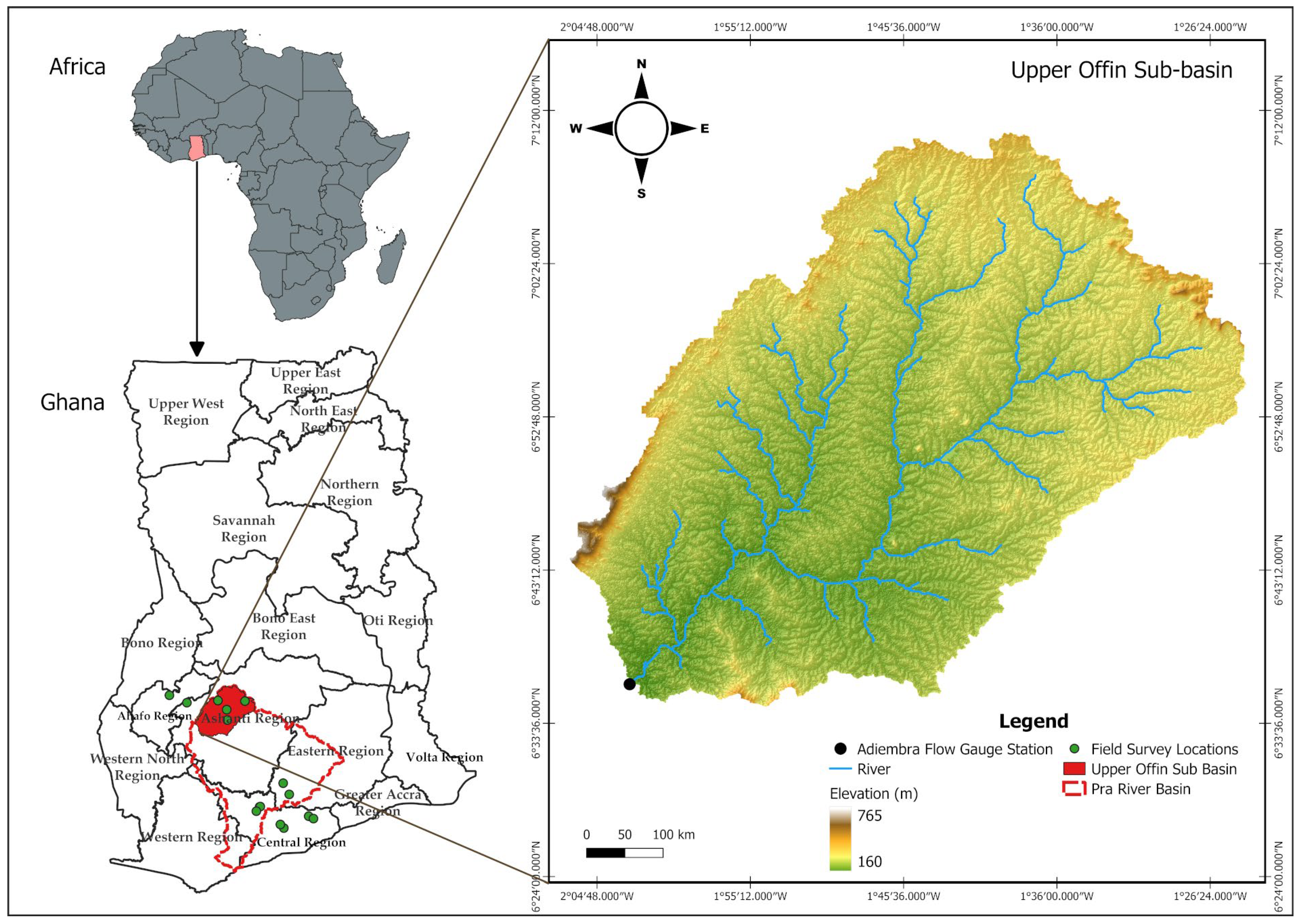
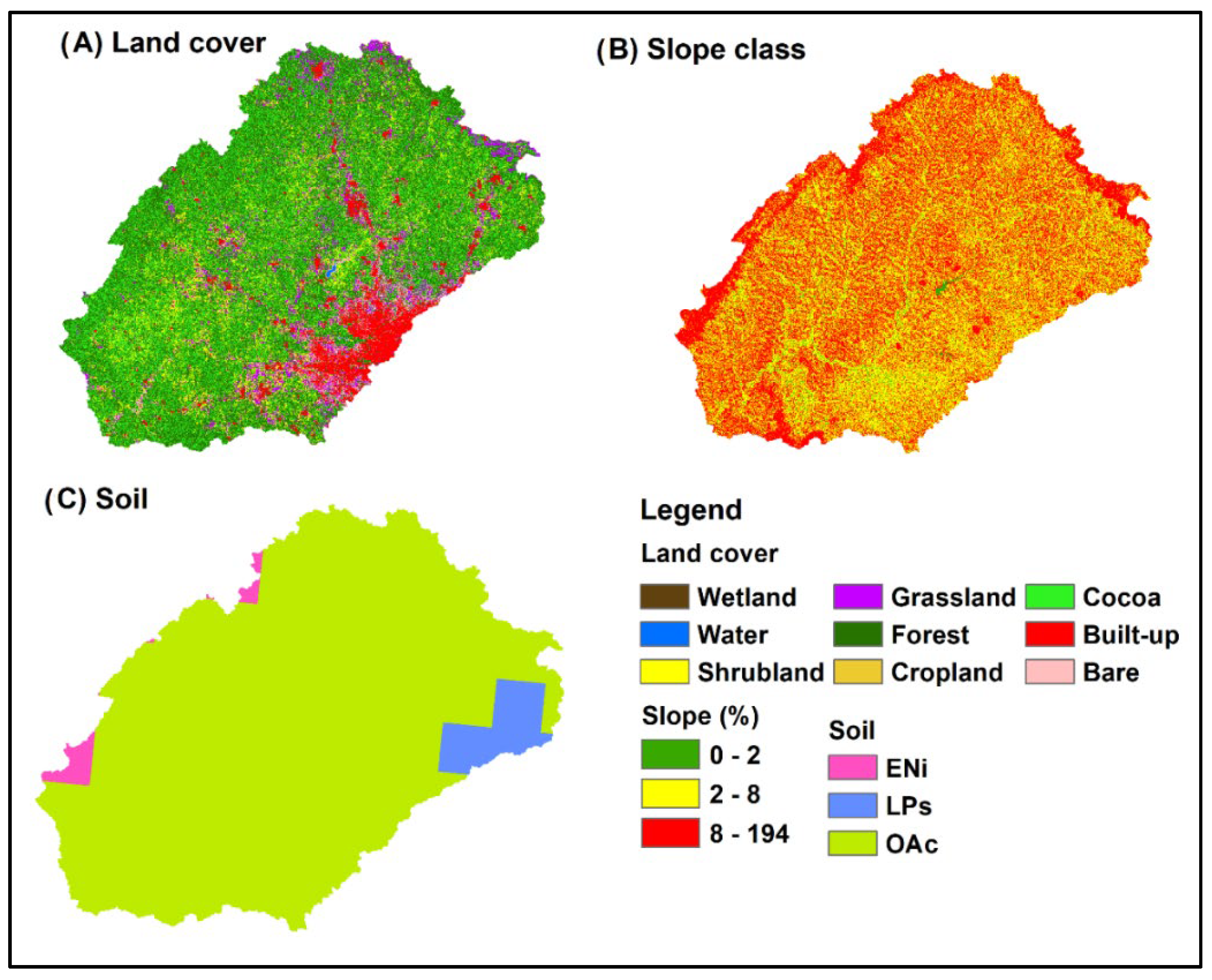
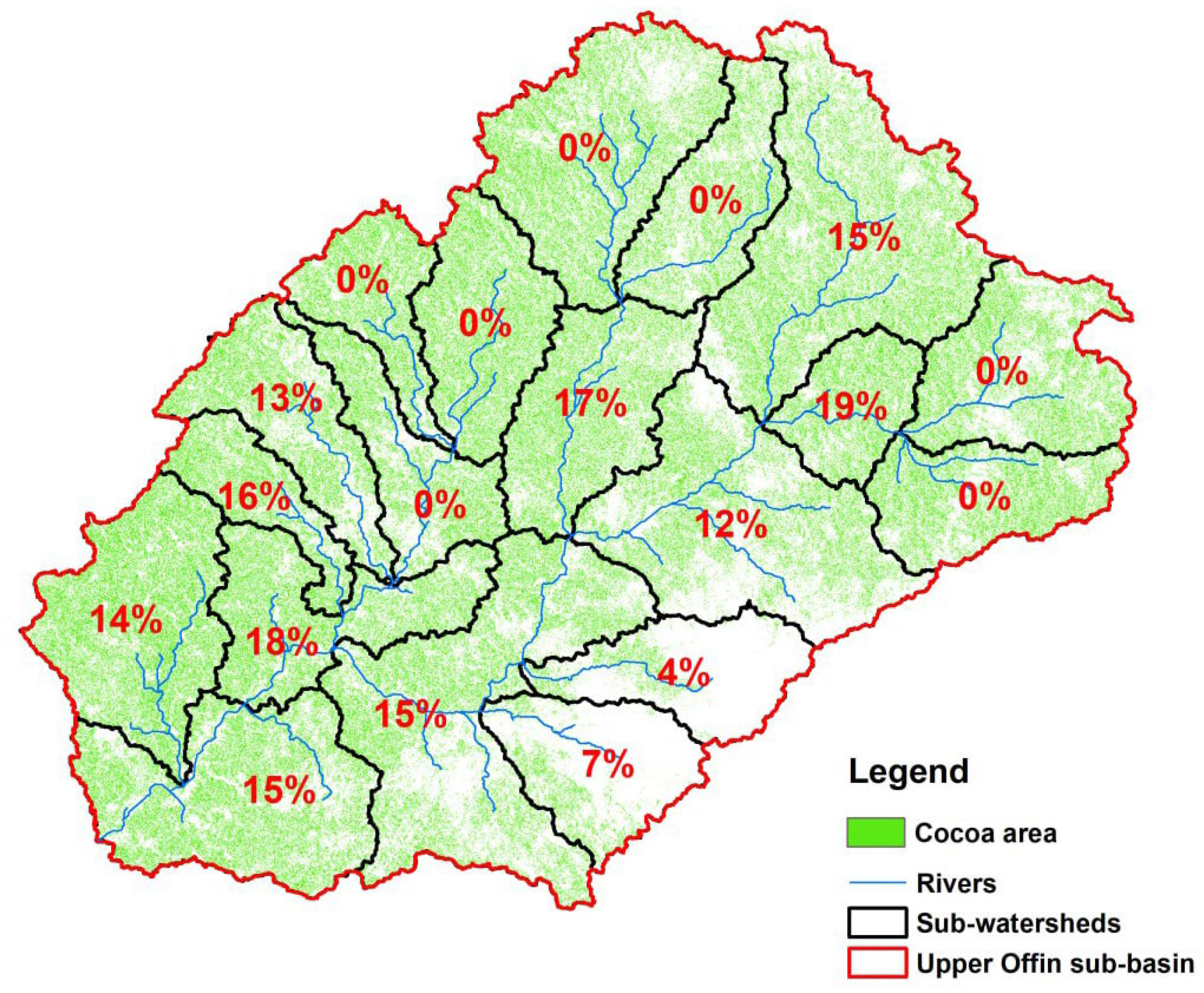
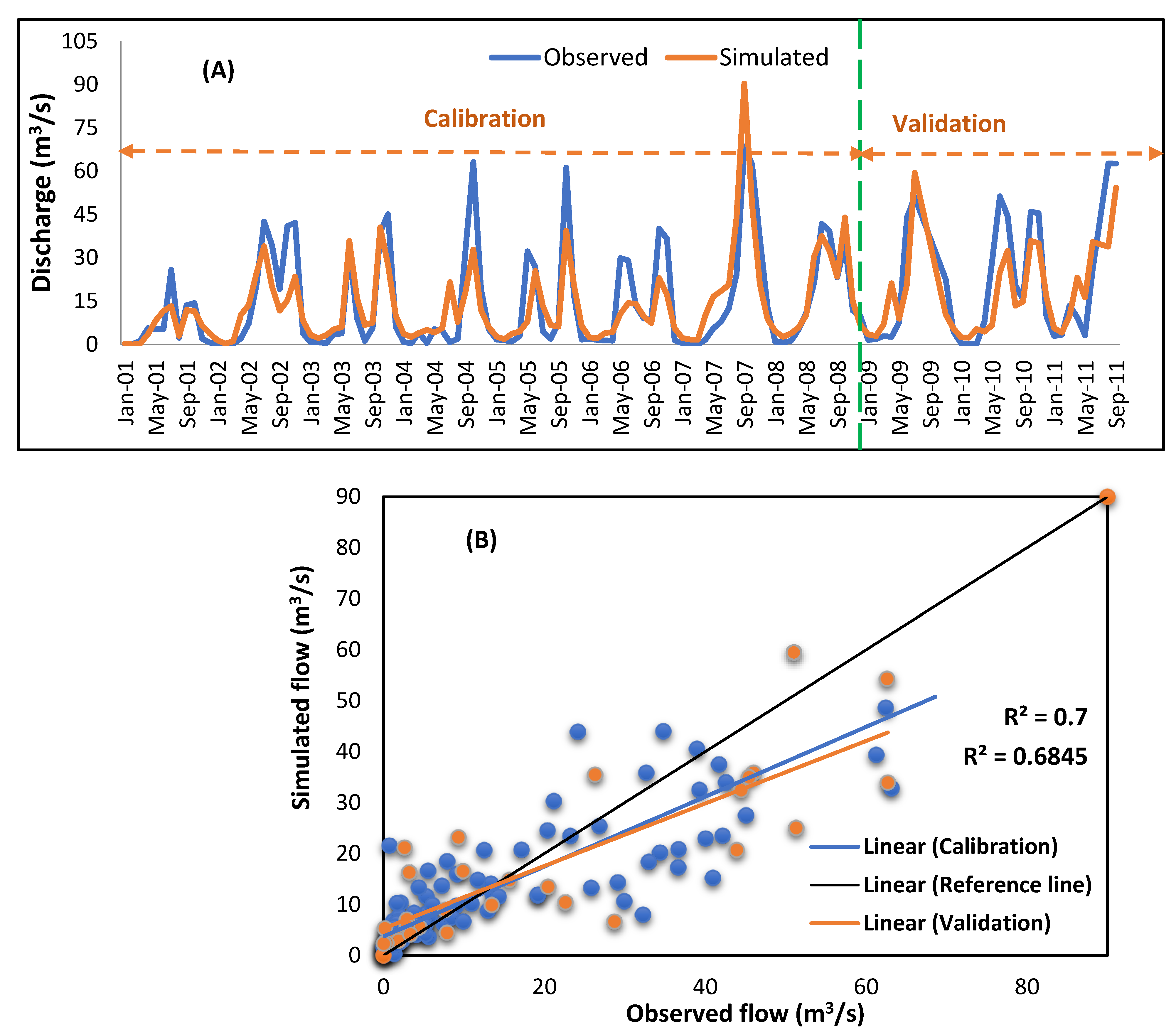
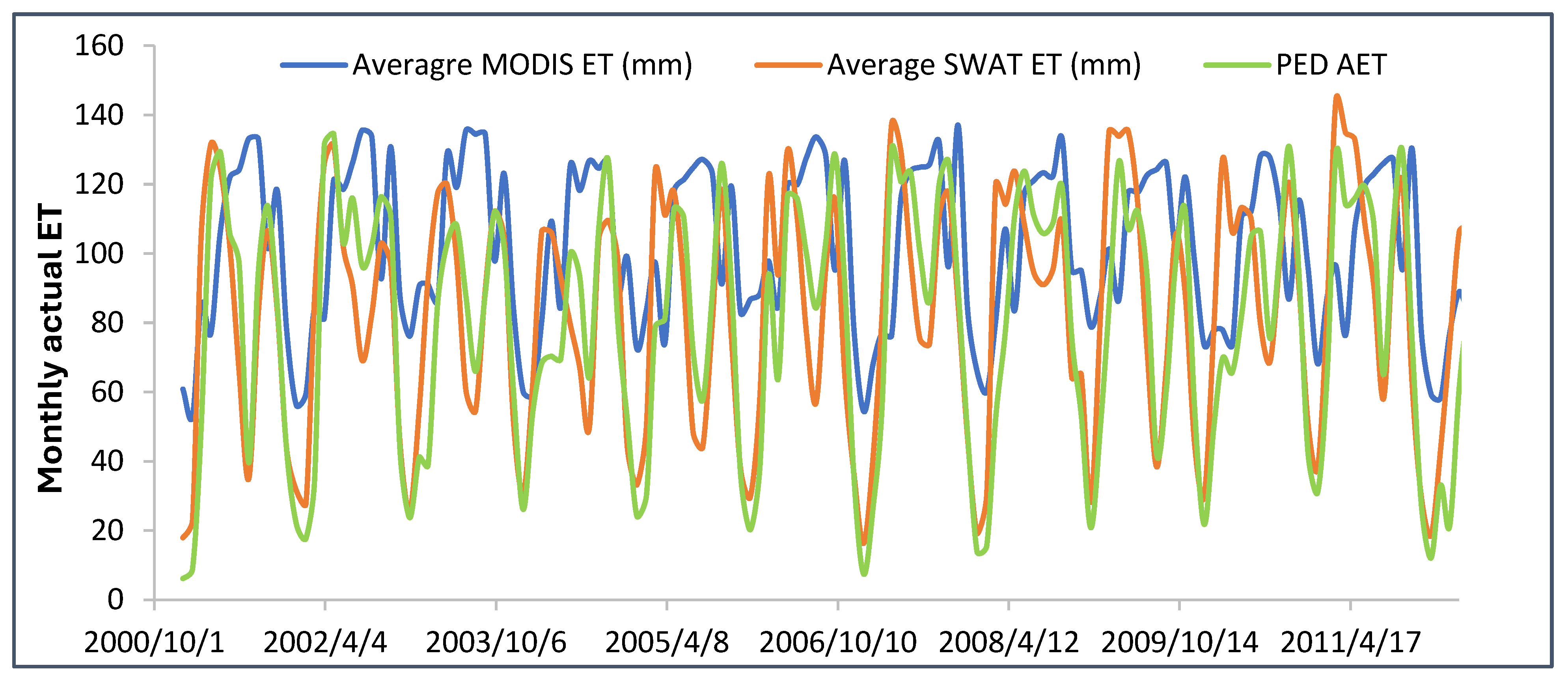
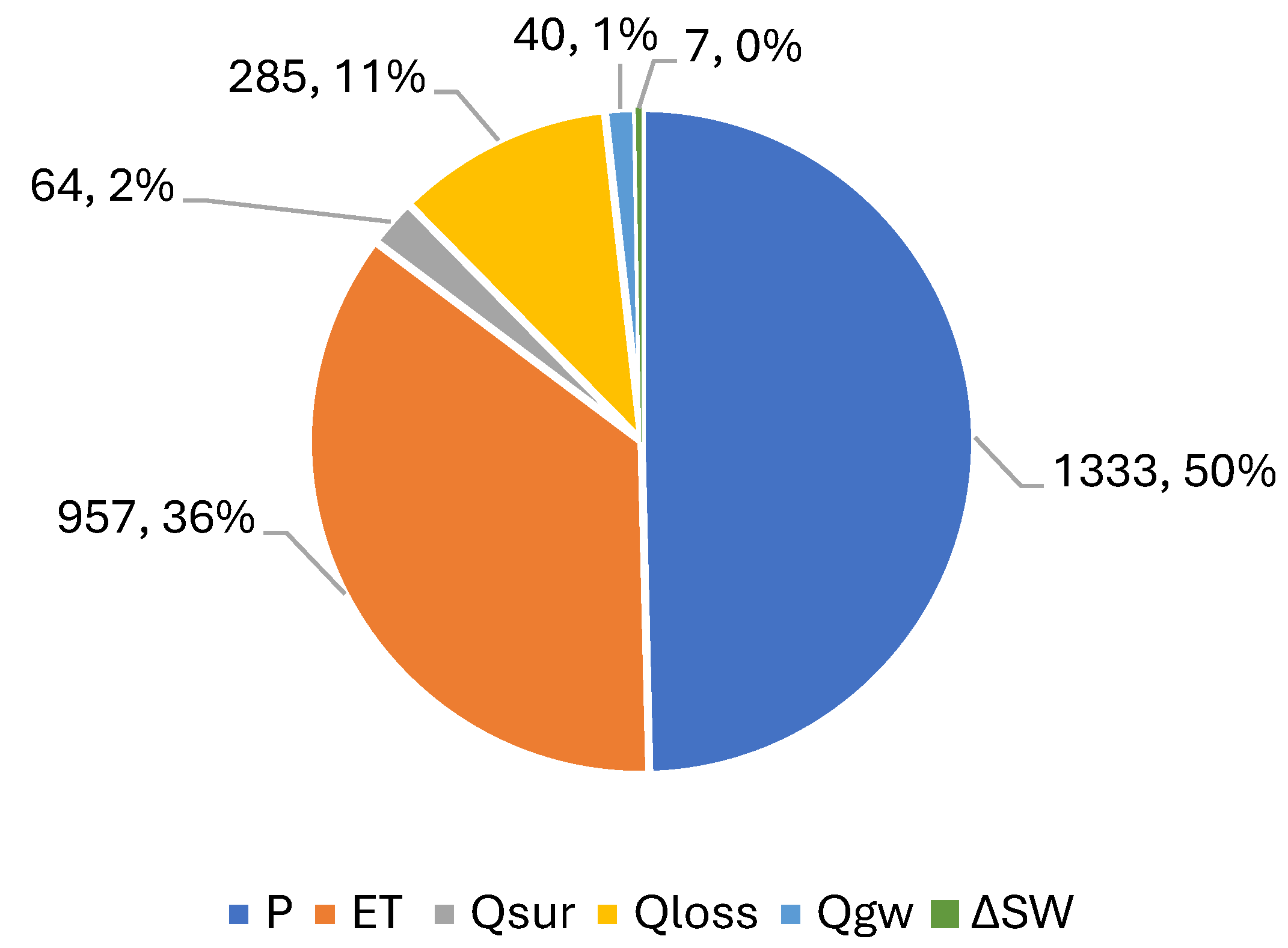
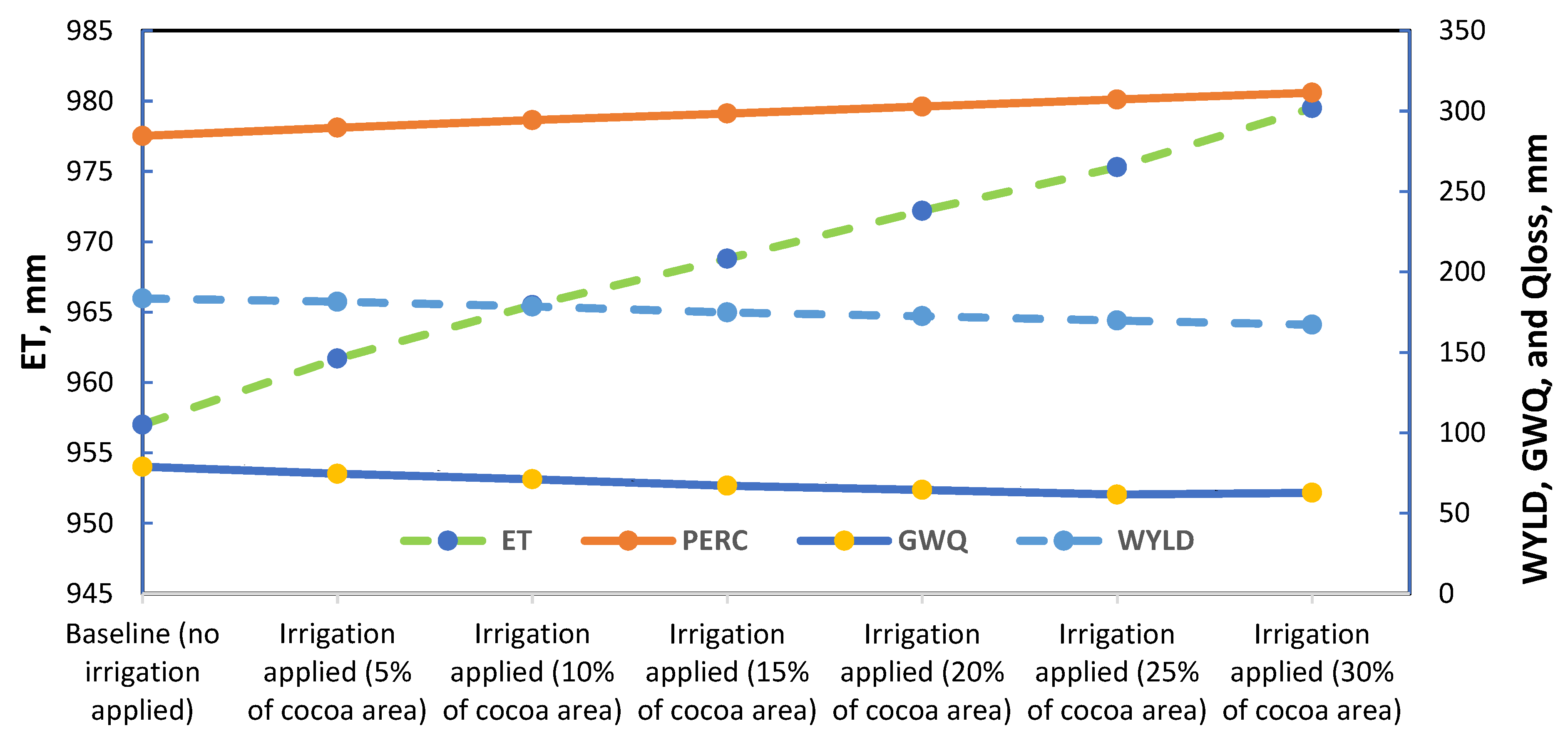
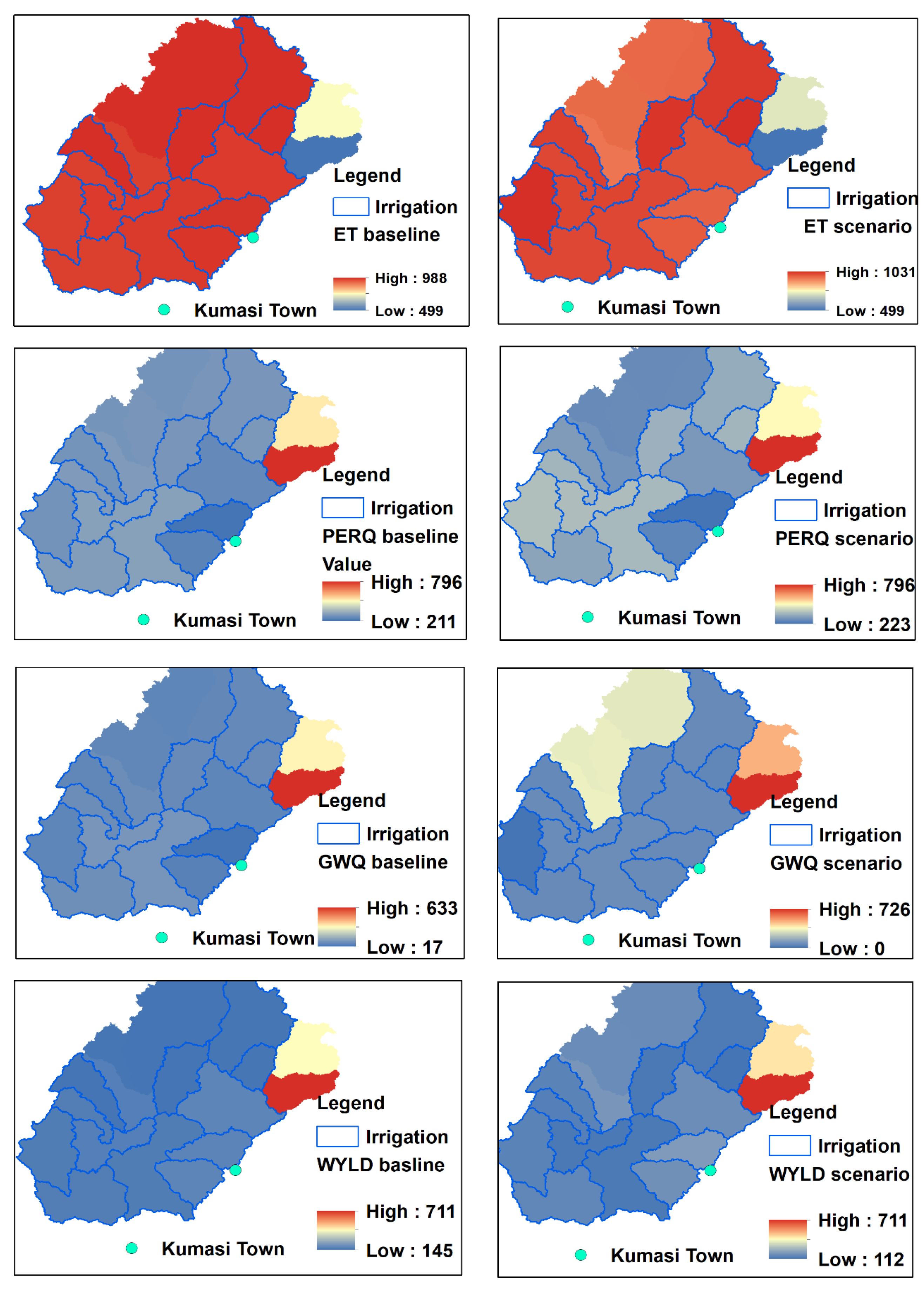
| Data | Source | Resolution (m/time) |
|---|---|---|
| Land use | European Space Agency, ESA, land covers 2020 | 10 m |
| Soil | Food and Agriculture Organization, FAO, through the World Soil Information, ISRIC | 250 m |
| SRTM DEM | United States Geographical Survey (USGS), 2000 | 30 m |
| Cocoa farm cover | Abu et al. [37] | 10 m |
| Rainfall (mm) | Climate Hazard Group Infrared Precipitation with Station (CHIRPS) | 5000 m |
| Temperature (OC) | European Centre for Medium-Range Weather Forecasts, ECMWF, Atmospheric Reanalysis for Global Climate (ERA5) | 24,000 m |
| Relative humidity, solar radiation, wind speed | Climate Forecast System Reanalysis (CFSR) | 55,000 m |
| Streamflow data | Ghana Hydrological Authority | daily |
| Farming practices | Field survey | - |
| Parameter | Name | Unit | Parameter Space |
|---|---|---|---|
| SCS runoff curve number | r_CN2.mgt | - | ±0.35 |
| Soil evaporation compensation factor | v_ESCO.hru | - | 0.01–1.0 |
| Average slope length | r_SLSUBBSN.hru | m | ±0.5 |
| Manning’s “n” value for overland flow | v_OV_N.hru | - | 0.01–0.3 |
| Surface runoff lag time | v_SURLAG.bsn | - | 0.0001–1.0 |
| Depth to impervious layer for modeling perched water tables | v_DEP_IMP.hru | mm | 0.0–6000 |
| Base flow alpha factor (days) | v_ALPHA_BF.gw | Days−1 | 0.0–1.0 |
| Threshold depth of water in shallow aquifer required for return flow to occur (mm) | v_GWQMN.gw | mm | 0.0–5000 |
| Groundwater “revap” coefficient | v_GW_REVAP.gw | - | 0.02–0.2 |
| Manning’s “n” value for the main channel | v_CH_N2.rte | - | 0.01–0.3 |
| Average slope of main channel | r_CH_S2.rte | m/m | ±0.5 |
| Available water capacity of the soil layer | r_SOL_AWC().sol | mm H2O/mm soil | ±0.25 |
| Depth from soil surface to bottom of layer | r_SOL_Z().sol | mm | ±0.25 |
| Saturated hydraulic conductivity | r_SOL_K().sol | mm h−1 | ±0.25 |
| Average slope of tributary channels | r_CH_S1.sub | m/m | ±0.5 |
| Manning’s “n” value for the tributary channels | v_CH_N1.sub | - | 0.001–0.3 |
| Variable | Mean |
|---|---|
| Age of cocoa trees (years) | 19.1 |
| Irrigated cocoa land (ha) | 3.05 |
| Plant density (number per ha) | 1154.7 |
| Cocoa yield (kg ha−1) | 425.7 |
| Fertilizer access (yes = 1, no = 0) | 0.88 |
| Types of fertilizer (inorganic = 1, organic = 0) | 0.86 |
| Number of fertilizer types used (single = 1, multiple = 0) | 0.64 |
| Rate of granular fertilizer application (kg ha−1) | 370.7 |
| Rate of foliar fertilizer application (mL ha−1) | 660.0 |
| Rate of organic fertilizer application (kg ha−1) | 2471.0 |
| Pesticide access (yes = 1, no = 0) | 1.0 |
| Rate of pesticide application (mL ha−1) | 470.0 |
| Frequency of pesticide application annually | 5.2 |
| Parameter | t-Stat | p-Value | Fitted Value | Actual Value | |
|---|---|---|---|---|---|
| v_CH_N1.sub | - | 8.73 | 0.000 | 0.39 | 0.39 |
| r_CH_S1.sub | m/m | −8.51 | 0.000 | −0.62 | 0.003 |
| r_CN2.mgt | - | −7.52 | 0.000 | −0.07 | 69.50 |
| v_GWQMN.gw | Mm | −6.77 | 0.000 | 3740.99 | 3740.99 |
| v_GW_REVAP.gw | - | −6.06 | 0.000 | 0.05 | 0.05 |
| v_OV_N.hru | - | 4.33 | 0.000 | 0.32 | 0.32 |
| r_SOL_Z().sol | Mm | −3.88 | 0.000 | −0.08 | * |
| v_ALPHA_BF.gw | Days−1 | 1.90 | 0.058 | 0.91 | 0.91 |
| r_CH_S2.rte | m/m | −1.73 | 0.085 | −0.17 | 0.002 |
| v_CH_N2.rte | - | −1.38 | 0.168 | 0.43 | 0.43 |
| r_SLSUBBSN.hru | m | −1.06 | 0.288 | −0.02 | 46.50 |
| r_SOL_K().sol | mm h−1 | −1.06 | 0.289 | 0.17 | * |
| v_ESCO.hru | - | 0.57 | 0.571 | 0.67 | 0.67 |
| r_SOL_AWC().sol | mm H2O/mm soil | −0.35 | 0.727 | −0.16 | * |
| v_DEP_IMP.hru | mm | −0.25 | 0.804 | 5984.19 | 5984.19 |
| v_SURLAG.bsn | - | −0.21 | 0.838 | 0.02 | 0.02 |
Disclaimer/Publisher’s Note: The statements, opinions and data contained in all publications are solely those of the individual author(s) and contributor(s) and not of MDPI and/or the editor(s). MDPI and/or the editor(s) disclaim responsibility for any injury to people or property resulting from any ideas, methods, instructions or products referred to in the content. |
© 2025 by the authors. Licensee MDPI, Basel, Switzerland. This article is an open access article distributed under the terms and conditions of the Creative Commons Attribution (CC BY) license (https://creativecommons.org/licenses/by/4.0/).
Share and Cite
Assefa, T.T.; Gbodji, K.K.; Atampugre, G.; Loh, Y.S.A.; Bayissa, Y.; Tilahun, S.A. Hydrological Implications of Supplemental Irrigation in Cocoa Production Using SWAT Model: Insights from the Upper Offin Sub-Basin, Ghana. Water 2025, 17, 1841. https://doi.org/10.3390/w17131841
Assefa TT, Gbodji KK, Atampugre G, Loh YSA, Bayissa Y, Tilahun SA. Hydrological Implications of Supplemental Irrigation in Cocoa Production Using SWAT Model: Insights from the Upper Offin Sub-Basin, Ghana. Water. 2025; 17(13):1841. https://doi.org/10.3390/w17131841
Chicago/Turabian StyleAssefa, Tewodros T., Kekeli K. Gbodji, Gerald Atampugre, Yvonne S. A. Loh, Yared Bayissa, and Seifu A. Tilahun. 2025. "Hydrological Implications of Supplemental Irrigation in Cocoa Production Using SWAT Model: Insights from the Upper Offin Sub-Basin, Ghana" Water 17, no. 13: 1841. https://doi.org/10.3390/w17131841
APA StyleAssefa, T. T., Gbodji, K. K., Atampugre, G., Loh, Y. S. A., Bayissa, Y., & Tilahun, S. A. (2025). Hydrological Implications of Supplemental Irrigation in Cocoa Production Using SWAT Model: Insights from the Upper Offin Sub-Basin, Ghana. Water, 17(13), 1841. https://doi.org/10.3390/w17131841







